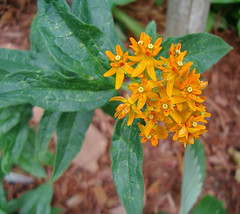Wordless Wednesday
Love and Peace Hybrid tea Rose:
Want to Join Wordless Wednesday’s? Sign up here:
Links to Other Wordless Wednesday Participants:
Please only list your name if you have a recent Wordless Wednesday post
What's blooming today?
by Tricia
by Tricia
Asclepias tuberosa
Native plant
 Height: 2-3 feet (60 to 90 cm)
Height: 2-3 feet (60 to 90 cm)
Blooming period: mid-summer
Exposure: full sun to light shade
Moisture: dry to average; drought tolerant
Habitat: prairies and meadows
Range: Prairies and Northeastern areas of North America
Description: Butterfly weed is one of the top butterfly attracting plants around. If one of the goals of your garden is to attract butterflies then this plant is a must. Clusters of orange flowers are borne at the top of 2 to 3 foot (60 to 90 cm) stems; leaves are narrow and dark green. Plants get bushy if they’ve got lots of room and, if crowded, stay narrow, straining for the sun. The seed pods are also very striking, large pods (4 to 6 inches/ 10 to 12.5 cm).
Maintenance and Requirements:
Butterfly weed prefers well-drained soil and will tolerate a broad range of conditions, from sand to clay, slightly acidic to neutral soil. Don’t let young seedlings dry out, but once established, plants are very drought tolerant. Butterfly weed emerges quite late in the spring, so be careful not to cultivate around it, as it doesn’t like disturbance.
Propagation:
Easy to start from seeds, which mature in Autumn. When seedlings are of transplantable size, place them in their permanent home, as butterfly weed’s long taproot resents being moved. You can also divide rootstalk in early spring or fall.
Good Companions:
Butterfly weed looks wonderful with almost any summer-blooming prairie natives, especially Blazing star (Liatris spp.), Prairie phlox (phlox pilosa), and Leadplant (Amorpha canescens), but for something a bit different, try planting it at the edge of a woodland garden, in a place where it will get sun. Also looks great with June grass (Koeleria cristata), which grows in clumps 1 to 2 feet (30 to 60 cm) tall and has fuzzy, spiky seedheads.
Related Species:
Though the common milkweed (A. syriaca) is a much-maligned plant, many of the milkweed species are not only very controlled plants, but are also very good candidates for prairie and northeastern gardens. One of the most graceful is whorled milkweed (A. verticillata), which has very slender leaves and airy clusters of small white flowers for many weeks in the summer.
Wildlife:
Milkweeds are the larval host plant for the Monarch butterfly and also the Queen butterfly. Their nectar attracts many other butterfly species and bees.
by Tricia
Growing Black-eyed Susans
A popular native plant
Name: Black-eyed Susan (Rudbeckia hirta)
Height: 1-3 feet (30 – 90 cm)
Blooming period: Summer to fall
Exposure: Full sun to partial sun
Moisture: average to dry; drought tolerant
Habitat: dry meadows, prairies, open woods
Range: Northeastern, and prairie areas of North America
The Rudbeckia is one of the most popular of the native wildflowers.
Black-eyed Susans are a must in the meadow or prairie garden. It’s prolific, long lasting blooms – yellow with dark centers – and its ease of cultivation make it a rewarding plant. Although it’s often listed as a biennial, black-eyed Susan will behave as a perennial if it’s happy and an annual if it’s not.
Maintenance and Requirements:
Black-eyed Susan thrives in tough conditions – in sandy or gravelly, nutrient-poor soil and long periods of drought. Don’t supplement the soil with fertilizer or organic material such as compost before planting, as you don’t want the soil to be too rich. If the soil is too rich there will be few blooms and and weaker stems. Acidic to neutral soil, clay or sand are best for this easy plant.
Propagation:
Easty to start from seeds, which ripen in fall, or divide mature plants in early spring or in fall.
Good Companions:
Black-eyed susan looks great with almost any of the native prairie and meadow species, but it looks particularly nice with airy white flowers such as flowering spurge (Euphorbia corallata), Pearly everlasting (Anaphalis margaritacea), and with the brilliant orange butterfly weed (Asclepias tuberosa), or the deep blue-purple of Delphinium exaltatum.
My own Black eyed susan plants (Rudbeckia fulgida ‘Goldsturm’) are planted near purple Salvia nemorosa, White phlox (Phlox paniculata ‘David’), and a Hosta Gold standard.
Related Species:
Brown-eyed Susans (R. triloba) has smaller blossoms, but they are more abundant than R. hirta, and the whole plant is bushier, with many branches. Sweet black-eyed Susan (R. subtomentosa) is much taller, to 6 feet (1.8 m). Green-headed coneflower (R. laniniata) is also very tall (3 to 8 feet /.9 to 2.4 m) and grows in the open shade of woodlands or in sun, blooming in summer.
Wildlife:
Nectar attracts butterflies and bees.